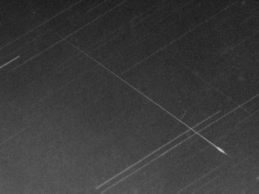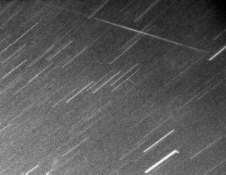Perseids 2002
Somewhat overshadowed in recent years by the Leonids, August's Perseid meteor shower remains a favourite target for even casual observers, given the dependably strong activity and abundance of bright events close to the peak. The past few returns have been relatively poorly observed from he UK thanks to cloud, moonlight or the two in combination. This year, moonlight, at least, will not be a problem: New Moon falls on August 8, leaving dark skies for the Perseids' most active period. Hopefully, this year will present the opportunity to emulate past observational successes.
The Perseids have long occupied a special place in the observing calendar for Scottish astronomers. Going back 25 years, 1977 saw a concerted drive to cover the shower coordinated by Robert McNaught. The weather was kind, and a huge total of observations was amassed showing the shower to be living up to its then reputation as the year's strongest. With the (much-needed!) revitalisation of the BAA Meteor Section in the early 1980s following the appointment of George Spalding - another Scot! - as Director, I found myself in the position of being his regional representative, and was fortunate to be able to encourage large numbers of observers to contribute reports during this time. For a few years, it became something of a tradition to hold SAG "pre-Perseid" meetings to update potential watchers on what was likely to be seen, and the observations required. Good returns on this effort were had in 1980, 1982 and 1983. The 1980 Perseids are well remembered for their unusually high activity, while the 1983 shower was attended throughout by gloriously clear skies!
Subsequent observing campaigns have also been well supported, but many of the most prolific contributors of the 1980s have moved away, leaving Scottish meteor coverage in the hands of a dedicated few - regulars such as Tom McEwan, Brian Kelly and Dave Gavine, for example. As one of the exiles, and having been appointed to succeed George Spalding as Director in 1992, I am keen to see renewed and increased SAG area participation in the BAA Meteor Section's continuing work: the Perseids of 2002 present a good opportunity for newcomers to get involved or, indeed, for "lapsed" observers to rediscover the pleasure of meteor watching!

A mag. -3 Perseid recorded on Ilford HP5plus
film using a Lubitel 166 camera at f/4.5, 1994
Aug 14d 01h 10m UT. (© Neil Bone)
Before going into detail on the 2002 shower, it would perhaps be appropriate to review the Perseids' origins and observational history and characteristics. The Perseids are produced by particles of debris (meteoroids) shed by Comet 109P/Swift-Tuttle. Earth runs through the comet's debris trail (meteor stream) between about July 25 and August 20 each year, encountering the richest parts close to August 12. when the shower maximum occurs. From a trickle of one or two per hour in late July, the shower builds steadily through the first ten days of August, then "kicks" around Aug 10-11 to reach a sharp maximum on Aug 12-13, following which there is a rapid decline. Observed rates are typically in excess of 20/hr from a dark site between Aug 8-9 and 14-15, and can be much higher - perhaps 60-70/hr - at peak.
This regular activity pattern was somewhat altered in the late 1980s and early 1990s, around the time of the parent comet's perihelion. Having been "lost", Swift-Tuttle was recovered in the autumn of 1992, and encounters between Earth and a recently-ejected filament of meteoroidal material in 1993 and 1994, particularly, led to short-lived bursts of very high Perseid activity (up to 8-10/minute) ahead of the established August 12 maximum. This additional activity was still evident, albeit much diminished, as recently as 1997, but is not expected to manifest n 2002. Understood with the benefit of hindsight, "surprises" like the onset of the early peak in 1988 are among the more obvious reasons why we need to continue following even supposedly well-understood showers like the Perseids year after year.
With the Moon well out of the way, the 2002 Perseids can be covered effectively from the beginning of August right through the peak interval. Meteor observing is one of the few astronomical activities which can be carried out effectively with no more equipment than the naked eye: wrap warmly against the cool night air, get comfortable in a deckchair and watch for and record meteors as they occur in your field of view! Novice observers may not have the patience for the low rates up to about Aug 8-9, but more experienced hands should need no reminding of the importance of covering all nights - not just those when the highest activity is expected - during the shower. Likewise, the declining phase from Aug 13-14 shouldn't be neglected either. Maximum is expected around 22h UT on the Monday night to Tuesday morning of August 12-13, and I would expect rates to remain high throughout the hours of darkness.
The Perseids emanate from a radiant close to the "Double Cluster" at the north end of Perseus. This is actually circumpolar. early on an August evening, the radiant is low in the northeast, rising higher as the night goes on and being highest - approaching 70 degrees elevation - as dawn arrives. All else being equal, Perseid rates are highest when the radiant is well up in the sky.
Perseids appear all over the sky, and can be identified by tracing their paths backwards in the mind's eye, aided by a straight-edge. Meteors whose back-extended paths cross an 8-degree circle centred on the radiant can be taken to be Perseids. Others will be random-direction sporadics, or perhaps members of the Delta Aquarid, Iota Aquarid or Alpha Capricornid showers whose radiants lie low in the southeast. Remember that all meteors should be recorded, not just the Perseids! Best viewing direction for visual watches is about 40 degrees in azimuth from the radiant, at an elevation of 50 degrees above the horizon.
Full details of how to go about visual meteor watching can be found on the BAA Web site at http://www.britastro.org./~meteor
To reiterate the basics, watches should ideally be of at least 1 hour duration, with breaks in between for refreshment if necessary (remember, meteor observing is supposed to be fun, too - not an exercise in endurance as some would have it!). Dates should be recorded in double-date form, such that Aug 12-13 is the night of Aug 12 to the morning of Aug 13, for example. As elsewhere in astronomy, always use Universal Time (UT, the same as GMT). For the observations to be of use in subsequent analysis, it is vital that a record be kept of the sky conditions - stellar limiting magnitude and obscuration by cloud, particularly.
Records for individual meteors should include at a minimum the time of appearance to the nearest minute and type. Magnitude estimates, using background stars or planets for comparison (see Table) are also useful. The Perseid stream has a retrograde orbit, meaning that meteoroids swept up by Earth collide almost "head-on", releasing a lot of energy in the atmosphere 100 km (60 miles) up. As a result, Perseids are often bright, and many leave behind persistent ionisation trains - rather like a "ghost" of the meteor sometimes taking several seconds to fade away. It is useful to record the presence and duration of such trains. If photography is being attempted (see below) it can help in subsequently identifying trails to note the constellation in which the meteor appeared. Other useful notes might include a record of pronounced colour, or flaring and fragmentation along the track.

Mag. -5 Perseid above Sagitta1993 August
12d 21h 37m UT. Overhead in Sussex, this
meteor was visible as far north as the
Borders! Ilford HP5plus, 29 mm wide-angle
lens, 15 min exposure. (© Neil Bone)
Reports made in this disciplined manner can be combined with those of other observers in later analyses to derive corrected Zenithal Hourly Rates for the shower, and reveal other characteristics such as the abundance of large particles (producing the brighter events) in the meteor stream. There is a big difference between this sort of observing and what I would call "just looking"; the latter, sadly, afflicted all too many accounts of the Leonids in recent years, where the witnesses have claimed to have seen plenty of meteors, but cannot furnish numbers, watch times or other information which would lend scientific value!
The Perseids have always been viewed as good for photography. This should be carried out using fast (ISO 400 ) film and a tripod-mounted camera fitted with an f/2.8 or faster lens. My preference is for a 28 mm wide-angle to take in a reasonable field of view. Time exposures of 15-20 minutes (depending on sky darkness), with the camera aimed 20-30 degrees from the radiant (Cygnus or the Square of Pegasus, say) should suffice. There is no need to drive the camera. As in the images here, the stars will show as short trails, while any recorded meteors will be longer streaks cutting across them. Remember, however, that only the brighter meteors (mag. 0 and better) will record, and even close to Perseid maximum you may have to take several hours exposure to catch a single trail. Also beware of satellites passing through the field of view - these can leave meteor-like trails! It can be useful to have a record of exposure times (including those frames without meteors) for comparison with visual data obtained at the same time.
This Augusts Perseids are the best meteor observing opportunity to have come our way for some time. Weather permitting, this will hopefully prove a successful and enjoyable campaign. Also worthy of attention later in the year are the Leonids - one last-gasp chance of a storm over Europe around 2002 November 19d 04h UT under moonlit conditions - and the Geminids close to December 13-14. Indeed, in recent years, the Geminids have out-performed the Perseids, and observers braving the cold of a December night should be well rewarded for their efforts.
Reports from SAG area observers of the Perseids, and other meteor showers, will always be welcomed by the BAA Meteor Section, which remains the UK's principal body for collecting such data. Results can be sent either to regional coordinator Brian Kelly ,13 Rowanbank Gardens, Broughty Ferry, Dundee, DD2 2UB, or to me at "The Harepath", Mile End Lane, Apuldram, Chichester, West Sussex, PO20 7DZ. Tel. (01243) 782679. e-mail